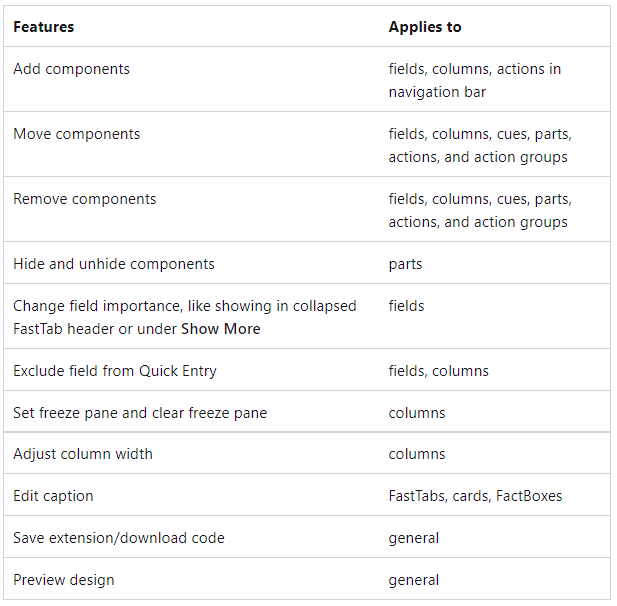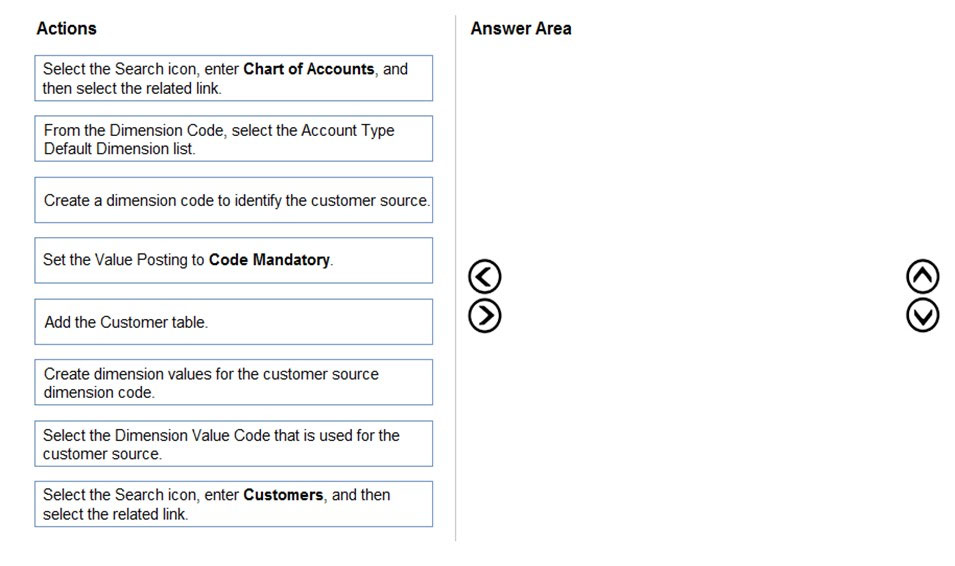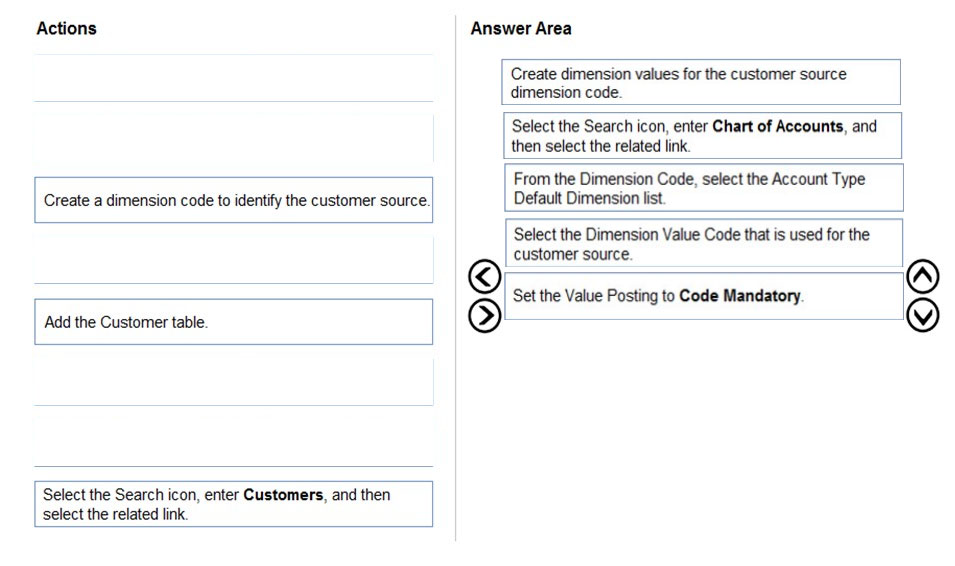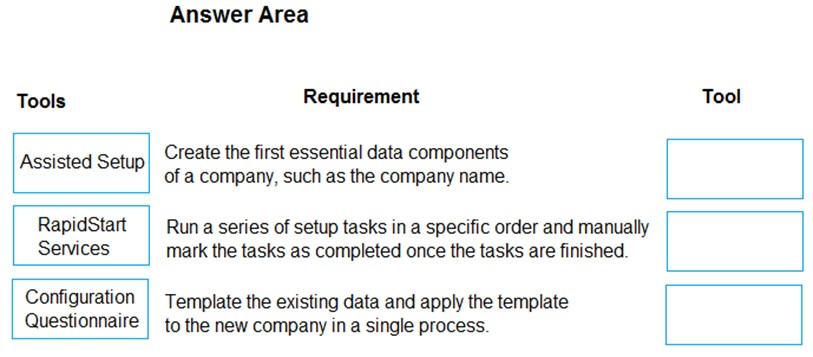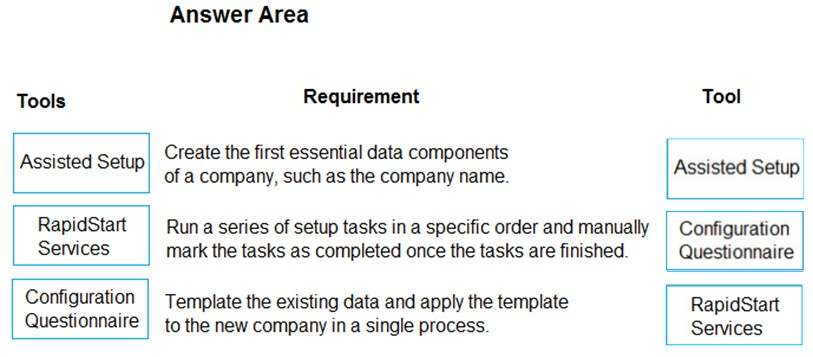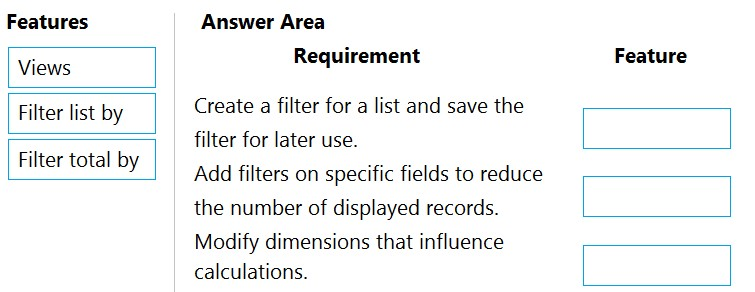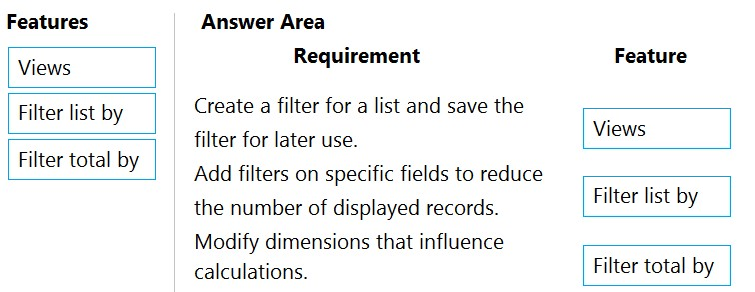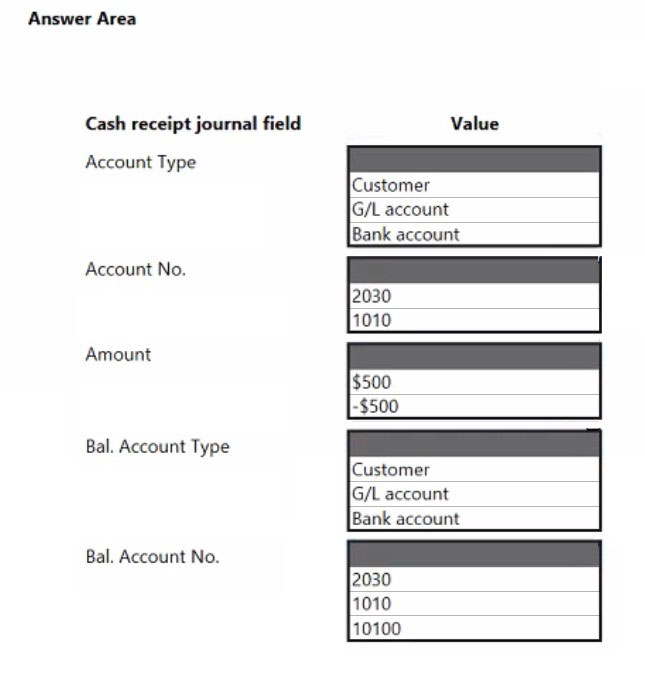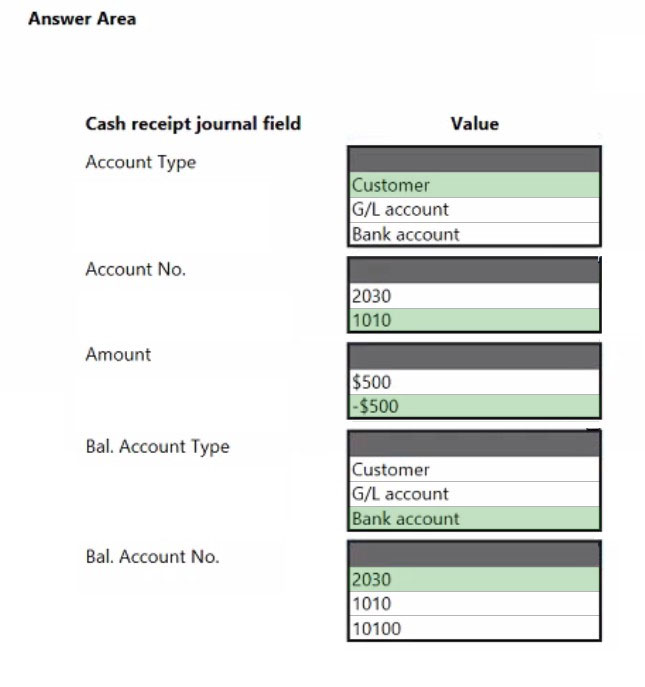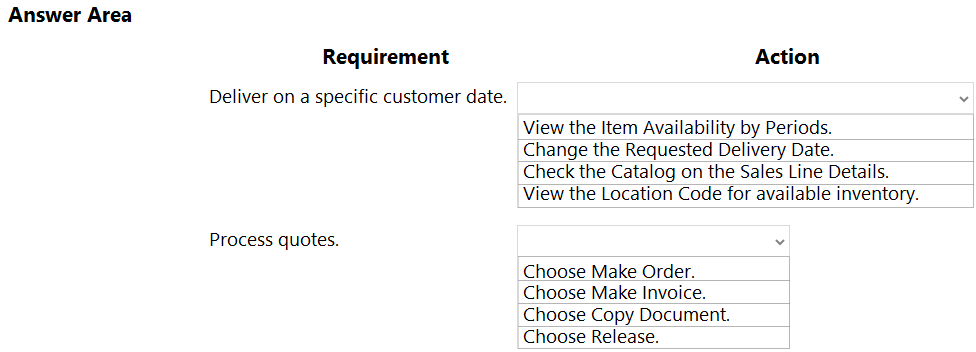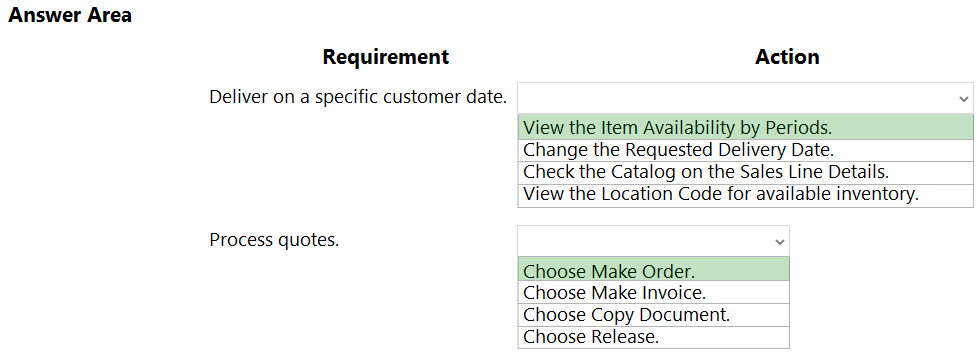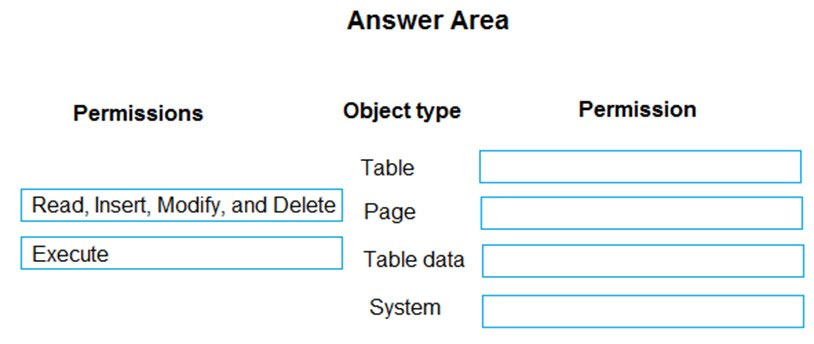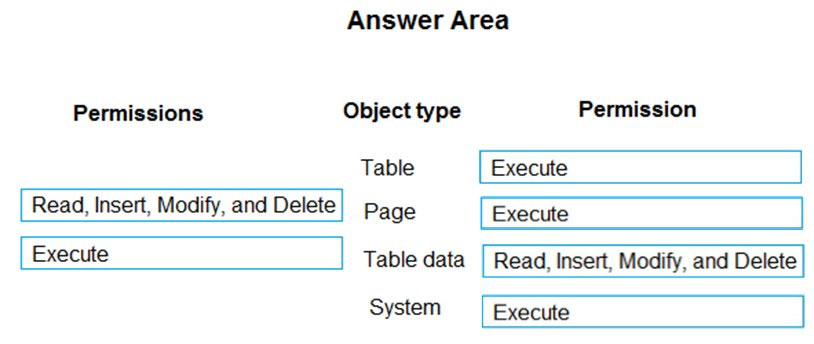MB-800 Practice Questions Free – 50 Exam-Style Questions to Sharpen Your Skills
Are you preparing for the MB-800 certification exam? Kickstart your success with our MB-800 Practice Questions Free – a carefully selected set of 50 real exam-style questions to help you test your knowledge and identify areas for improvement.
Practicing with MB-800 practice questions free gives you a powerful edge by allowing you to:
- Understand the exam structure and question formats
- Discover your strong and weak areas
- Build the confidence you need for test day success
Below, you will find 50 free MB-800 practice questions designed to match the real exam in both difficulty and topic coverage. They’re ideal for self-assessment or final review. You can click on each Question to explore the details.
DRAG DROP - You have multiple, unpaid posted purchase invoices to reverse. Some invoices require complete reversal while others need partial reversal. You need to process credit memos from the posted purchase invoices page. Which actions should you perform? To answer, drag the appropriate action buttons to the correct requirements. Each action button may be used once, more than once, or not at all. You may need to drag the split bar between panes or scroll to view content. NOTE: Each correct selection is worth one point. Select and Place:
A company uses Dynamics 365 Business Central to record payments for vendors. All payment records include similar data elements. You are onboarding a new vendor. You must create a unique number series for payments from the vendor. No other vendors will use the new number series. You need to configure the system. What should you use?
A. Vendors
B. General Journals
C. General Journal template
D. Payment journals
E. Workflow
A company uses Dynamics 365 Business Central. The company performs an annual review of customer prices and determines that sales prices must rise by 10% for the coming year. You need to adjust the prices. What should you do?
A. Use the action Copy Prices.
B. Use the action Suggest Item Price on Worksheet.
C. Implement price changes to the sales price worksheet.
D. Manually add new lines to the Sales Lines Discount page.
A company has been using Dynamics 365 Business Central for many years. A new accounting manager for the company reviews the chart of accounts. The manager wants to remove some general ledger accounts. The Check G/L Account Usage field is selected in the General Ledger Setup. You need to assist with the account deletions. What is one requirement that enables deletion of a general ledger account?
A. The account cannot be used in any posting groups or posting setup.
B. The general ledger account is configured to allow for deletion.
C. The general ledger account cannot allow for direct posting.
D. The general ledger account must be of the type Balance Sheet.
You are implementing Dynamics 365 Business Central. You are unable to view some expected functionality in the system. You need to demonstrate the use of different options for assigning profiles to users. In which three places can you assign profiles to users? Each correct answer presents a complete solution. NOTE: Each correct selection is worth one point.
A. Assign a User Group to the user. Assign the Profile to the User Group.
B. Assign a Profile on the User Personalization page.
C. Assign the Profile on the User card.
D. Accept the default Profile.
E. Add the user to the Profile card.
You are configuring Dynamics 365 Business Central security settings. You assign the following permission sets to a user:You need to determine how the system handles the user's permissions. What is the outcome of the user permission configuration?
A. The Yes option will allow a user to create a new customer.
B. The permission set order will allow a user to create a new customer.
C. The Blank option will allow a user to create a new customer.
You need to configure the system to meet the requirements for sending invoices. Which three actions should you perform? Each correct answer presents part of the solution. NOTE: Each correct selection is worth one point.
A. Set Email to Yes (Use Default Settings).
B. Allow Sender Substitution for SMTP Mail Setup.
C. Set Email to Yes (Prompt for Settings).
D. Assign a Document Sending Profile to the Customer where Email is set to No.
E. Apply Office Server Settings to the SMTP Mail Setup.
F. Assign a Document Sending Profile to the Customer where Email is set to Yes.
A company uses Dynamics 365 Business Central to manage receivables. You must import a series of payments from a bank account and automatically match the payments against similar ledger entries already entered in Business Central. You need to import and apply the payments to the ledger entries that are automatically matched by the system. Which form should you use?
A. Payment services
B. Payment Application Rules
C. Payment Reconciliation Journal
D. Payment Registration
You are implementing Dynamics 365 Business Central for a customer who has two warehouses. The customer requires the following: ✑ different item pricing and vendors set up for items in each warehouse ✑ transactions tied to a specific location You need to configure Business Central per the customer requirements. Which three entities should you configure? Each correct answer presents part of the solution. NOTE: Each correct selection is worth one point.
A. Inventory setup
B. Warehouse setup
C. Stockkeeping units
D. Item card
E. Locations
Case study - This is a case study. Case studies are not timed separately. You can use as much exam time as you would like to complete each case. However, there may be additional case studies and sections on this exam. You must manage your time to ensure that you are able to complete all questions included on this exam in the time provided. To answer the questions included in a case study, you will need to reference information that is provided in the case study. Case studies might contain exhibits and other resources that provide more information about the scenario that is described in the case study. Each question is independent of the other questions in this case study. At the end of this case study, a review screen will appear. This screen allows you to review your answers and to make changes before you move to the next section of the exam. After you begin a new section, you cannot return to this section. To start the case study - To display the first question in this case study, click the Next button. Use the buttons in the left pane to explore the content of the case study before you answer the questions. Clicking these buttons displays information such as business requirements, existing environment, and problem statements. If the case study has an All Information tab, note that the information displayed is identical to the information displayed on the subsequent tabs. When you are ready to answer a question, click the Question button to return to the question. Background - Northwind Traders is an independent, family-owned business. The company distributes natural pet products in the Northwest region of the country/region. Products are purchased directly from manufacturers and distributed by using its own fleet of trucks. When the company started, deliveries were within a three-hour radius of the warehouse. Due to regional growth, current deliveries require drivers to stay overnight on some routes. The company plans to open a second warehouse to expand the region and eliminate overnights for route drivers. The company also plans to hire a second group of employees to run operations in this new location. The finance and accounting teams will remain in the original location. The company uses a third-party system for financials and order management. The finance department stated that the company’s fiscal year begins on July 1 and ends on June 30. The mm/dd/yyyy date format is used. As part of the expansion, the owner plans to upgrade to an ERP system and use Business Central to fulfill the company requirements and manage growth. Current environment - Orders - • Orders are emailed to customer service and manually keyed into the inventory system. Pricing and discounts - • Customer pricing is determined by the customer market type. Customer market types are Retail, Veterinarian, and Breeder. Each customer is associated with only one market type. • Vendors offer monthly promotions to customers by item, brand, or item category. • Invoices should show each customer’s base price, the discount amount, and the net price. Accounts payable - • The company wants to expand vendor payment options in the new system. Requirement - Customers - • The sales team must be able to do the following: o Quickly set up new customers with the proper settings based on customer type. o Identify customers by market type. Customer posting groups will be used to identify which market the customer belongs to. • Base price is determined by the customer market type. • The sales department should receive a warning when entering the order if a customer is over their credit limit. Sales - • Customer discounts are offered for specific time frames by item, brand, or product category. Discounts should be added to sales lines automatically. • Discounts must post to a unique general ledger (G/L) account. • The business needs to be able to track revenue by location, market, and product category dimensions. Locations 100 and 200 will be set as default dimensions on the two warehouse locations. Food, treats, toys, and supplies are the required product categories, which will be set as default dimensions on the item cards. Each customer card will have a default market dimension. • The sales manager wants to delete canceled orders and automatically archive them. Warehouse - • Orders will be fulfilled from two possible warehouse locations. • Product will be transferred between locations by using transfer orders. Sales invoices - • Invoices will be posted after delivery. • Invoices will be emailed to the customer. • The sales department must be able to quickly correct posted invoices for the following scenarios: o Posted invoices that have not been paid. o Posted invoices that have been paid. o Posted invoices created from sales orders. o Posted invoices not created from sales orders. Accounting - • The finance department requires that the company has 12 monthly accounting periods per fiscal year. • Finance department users must be able to reconcile the accounts receivable (AR) subledger to the G/L account at month end. • AR department users need the ability to settle and close invoices when customers take payment discounts after the payment discount date has passed. AR users should be allowed to accept or reject the payment tolerance. • Accounts payable (AP) department users must be able to pay vendors by electronic funds transfer (EFT) and use a payment journal batch named EFT to process payments. • When viewing G/L entries, the finance and accounting teams must be able to see debits and credits instead of a positive or negative amount. • The company needs to be able to track expenses by department and location. The departments are sales, operations, and administration. • AR must be able to correct cash application entries. Issues - Payment application - • Customers may have several stores that are responsible for their own orders and payments. • Occasionally, AR clerks mistakenly apply payments to the incorrect customer invoice. Invoicing - • When items are delivered, customers refuse the items for reasons such as damaged or wrong item. • After the invoices are posted, they must be corrected, which is time-consuming. Warehouse - • The sales department and warehouse managers must have visibility into products that are in the process of being transferred between locations. Accounts - • Customer accounts are difficult to view by market type. • The finance team does not have the ability to report revenue by customer type. Accounting - • AR users often find variances between the AR subledger and G/L account. • Customers often take the payment discount after the payment discount date has passed, leaving open invoices for small amounts. • The AP department is unable to pay vendors by EFT in the current system. • Finance and accounting team members have trouble validating postings when they use only the amounts field on G/L entries. • The finance department is unable to run financial reports by market. All revenue postings must reference a market. You need to configure Business Central to display G/L entries as required by the accounting team. Which configuration should you use?
A. Show Amounts
B. Check G/L Account Usage
C. G/L Account Card
D. Debit/Credit
A user reports that they cannot create or view sales quotes in Dynamics 365 Business Central. You need to help the user create and view sales quotes. From which three cards can the user perform the required activities? Each correct answer presents a complete solution. NOTE: Each correct selection is worth one point.
A. Service Item
B. Opportunity
C. Job
D. Resource
E. Customer
F. Contact
A company records vendor-wise item descriptions. You need to set up vendor-specific descriptions for items. What should you set up?
A. Item variants
B. Substitutions
C. Item cross-references
D. Extended text
You are setting up a new company for a customer. The customer wants to sell items in D, but refer to the items as pieces. Each box contains 12 pieces. Each pallet contains 144 pieces. You need to assign the unit of measures to items. How should you assign the unit of measures?
A. Create Box as a base unit of measure. Add Pieces as an item unit of measure with the quantity per unit set to 0.08333.
B. Create Pieces as an item unit of measure with a quantity per unit of measure set to 1.
C. Create Pieces as a base unit of measure. Add Box as an item unit of measure with the quantity per unit set to 12.
D. Create Pallet as a base unit of measure. Add Pallet as an item unit of measure with the quantity per unit set to 12.
A customer has premium licenses for Dynamics 365 Business Central. You need to make all actions and fields for the Manufacturing and Service modules available to users. What should you do?
A. Assign users to the D365 BUS FULL ACCESS user group.
B. Select the Premium option in the Experience field on the Company Information page.
C. Assign SUPER permission sets to users.
D. Assign users to the D365 BUS PREMIUM user group.
E. Select the Custom option for the Company Badge field on the Company Information page.
Case study - This is a case study. Case studies are not timed separately. You can use as much exam time as you would like to complete each case. However, there may be additional case studies and sections on this exam. You must manage your time to ensure that you are able to complete all questions included on this exam in the time provided. To answer the questions included in a case study, you will need to reference information that is provided in the case study. Case studies might contain exhibits and other resources that provide more information about the scenario that is described in the case study. Each question is independent of the other questions in this case study. At the end of this case study, a review screen will appear. This screen allows you to review your answers and to make changes before you move to the next section of the exam. After you begin a new section, you cannot return to this section. To start the case study - To display the first question in this case study, click the Next button. Use the buttons in the left pane to explore the content of the case study before you answer the questions. Clicking these buttons displays information such as business requirements, existing environment, and problem statements. If the case study has an All Information tab, note that the information displayed is identical to the information displayed on the subsequent tabs. When you are ready to answer a question, click the Question button to return to the question. Background - Northwind Traders is an independent, family-owned business. The company distributes natural pet products in the Northwest region of the country/region. Products are purchased directly from manufacturers and distributed by using its own fleet of trucks. When the company started, deliveries were within a three-hour radius of the warehouse. Due to regional growth, current deliveries require drivers to stay overnight on some routes. The company plans to open a second warehouse to expand the region and eliminate overnights for route drivers. The company also plans to hire a second group of employees to run operations in this new location. The finance and accounting teams will remain in the original location. The company uses a third-party system for financials and order management. The finance department stated that the company’s fiscal year begins on July 1 and ends on June 30. The mm/dd/yyyy date format is used. As part of the expansion, the owner plans to upgrade to an ERP system and use Business Central to fulfill the company requirements and manage growth. Current environment - Orders - • Orders are emailed to customer service and manually keyed into the inventory system. Pricing and discounts - • Customer pricing is determined by the customer market type. Customer market types are Retail, Veterinarian, and Breeder. Each customer is associated with only one market type. • Vendors offer monthly promotions to customers by item, brand, or item category. • Invoices should show each customer’s base price, the discount amount, and the net price. Accounts payable - • The company wants to expand vendor payment options in the new system. Requirement - Customers - • The sales team must be able to do the following: o Quickly set up new customers with the proper settings based on customer type. o Identify customers by market type. Customer posting groups will be used to identify which market the customer belongs to. • Base price is determined by the customer market type. • The sales department should receive a warning when entering the order if a customer is over their credit limit. Sales - • Customer discounts are offered for specific time frames by item, brand, or product category. Discounts should be added to sales lines automatically. • Discounts must post to a unique general ledger (G/L) account. • The business needs to be able to track revenue by location, market, and product category dimensions. Locations 100 and 200 will be set as default dimensions on the two warehouse locations. Food, treats, toys, and supplies are the required product categories, which will be set as default dimensions on the item cards. Each customer card will have a default market dimension. • The sales manager wants to delete canceled orders and automatically archive them. Warehouse - • Orders will be fulfilled from two possible warehouse locations. • Product will be transferred between locations by using transfer orders. Sales invoices - • Invoices will be posted after delivery. • Invoices will be emailed to the customer. • The sales department must be able to quickly correct posted invoices for the following scenarios: o Posted invoices that have not been paid. o Posted invoices that have been paid. o Posted invoices created from sales orders. o Posted invoices not created from sales orders. Accounting - • The finance department requires that the company has 12 monthly accounting periods per fiscal year. • Finance department users must be able to reconcile the accounts receivable (AR) subledger to the G/L account at month end. • AR department users need the ability to settle and close invoices when customers take payment discounts after the payment discount date has passed. AR users should be allowed to accept or reject the payment tolerance. • Accounts payable (AP) department users must be able to pay vendors by electronic funds transfer (EFT) and use a payment journal batch named EFT to process payments. • When viewing G/L entries, the finance and accounting teams must be able to see debits and credits instead of a positive or negative amount. • The company needs to be able to track expenses by department and location. The departments are sales, operations, and administration. • AR must be able to correct cash application entries. Issues - Payment application - • Customers may have several stores that are responsible for their own orders and payments. • Occasionally, AR clerks mistakenly apply payments to the incorrect customer invoice. Invoicing - • When items are delivered, customers refuse the items for reasons such as damaged or wrong item. • After the invoices are posted, they must be corrected, which is time-consuming. Warehouse - • The sales department and warehouse managers must have visibility into products that are in the process of being transferred between locations. Accounts - • Customer accounts are difficult to view by market type. • The finance team does not have the ability to report revenue by customer type. Accounting - • AR users often find variances between the AR subledger and G/L account. • Customers often take the payment discount after the payment discount date has passed, leaving open invoices for small amounts. • The AP department is unable to pay vendors by EFT in the current system. • Finance and accounting team members have trouble validating postings when they use only the amounts field on G/L entries. • The finance department is unable to run financial reports by market. All revenue postings must reference a market. You need to configure payment discounts to resolve the issue reported by the AR users. Which two options should you configure? Each correct answer presents part of the solution. NOTE: Each correct selection is worth one point.
A. Sales & Receivables Setup
B. Payment Discount Grace Period
C. Payment Tolerance Warning
D. Pmt. Disc. Tolerance Warning
DRAG DROP - A company uses Dynamics 365 Business Central. You grant the financial bookkeeper the D365 ACCOUNTANTS permission set. An auditor plans to perform an annual accounting audit. The auditor must have access to the same data as the bookkeeper but with view-only permission. You need to create the permission set for the auditor. In which order should you perform the actions? To answer, move all actions from the list of actions to the answer area and arrange them in the correct order.
You are setting up a new company for a customer. The customer wants to sell items in boxes and pallets, but refer to the items as pieces. Each box contains 12 pieces. Each pallet contains 144 pieces. You need to assign the unit of measures to items. How should you assign the unit of measures?
A. Create Pieces as an item unit of measure with a quantity per unit of measure set to 1.
B. Create Pallet as a base unit of measure. Add Box as an item unit of measure with the quantity per unit set to 0.08333.
C. Create Pallet as a base unit of measure. Add Pieces as an item unit of measure with the quantity per unit set to 0.0069.
D. Create Pieces as a base unit of measure. Add Box as an item unit of measure with the quantity per unit set to 12.
DRAG DROP - A company is replacing their current solution with Dynamics 365 Business Central. During the user acceptance testing, you identify several gaps in the solution. You must add new functionality to the accounts receivable role center to allow order entry clerks to view the number of sales orders that they have created for the month to date. Clerks must be able to move the new role center element to another position on their interface. Accounts receivable clerks each have a specific order in which they enter sales order data. You must optimize the order entry process for these users. You need to configure the system. Which features should you use? To answer, drag the appropriate features to the correct requirements. Each feature may be used once, more than once, or not at all. You may need to drag the split bar between panes or scroll to view content. NOTE: Each correct selection is worth one point. Select and Place:
DRAG DROP - You need to ensure that any transaction that uses a customer account always includes the customer source dimension. Which five actions should you perform in sequence? To answer, move the appropriate actions from the list of actions to the answer area and arrange them in the correct order. Select and Place:
DRAG DROP - A company is implementing Dynamics 365 Business Central. You need to create a new company that is configured similarly to an existing company. The existing company has data that must be used as a template for the new company. Which tools should you use? To answer, drag the appropriate tools to the correct requirements. Each tool may be used once, more than once, or not at all. You may need to drag the split bar between panes or scroll to view content. NOTE: Each correct selection is worth one point. Select and Place:
You are implementing Dynamics 365 Business Central. You create items for infinite items such as water, electricity, and natural gas that are used in manufacturing processes. You need to set up the items. Which item type should you use for infinite items?
A. Resource
B. Inventory
C. Service
D. Non-Inventory
A company recently implemented Business Central. The company uses Teams extensively for day-to-day collaboration. The company finance manager must be able to search for contacts and share Business Central records in Teams. You need to install the Business Central app in Teams. What should you do first?
A. Select the Share action on Attachment Documents in Business Central.
B. Search for Teams App Centralized Deployment in Business Central.
C. Add a Planner tab to a team channel.
D. Manage apps in the Business Central admin center.
DRAG DROP - You set up a new company in Dynamics 365 Business Central. You need to demonstrate Page Inspection functionality. Which features should you use? To answer, drag the appropriate page inspection features to the correct display requirements. Each page inspection feature may be used once, more than once, or not at all. You may need to drag the split bar between panes or scroll to view content. NOTE: Each correct selection is worth one point. Select and Place:
DRAG DROP - A company uses Business Central to manage retail product pricing and discounts. The new sales pricing experience has not been enabled. The company plans to track discounts applied to sales transactions. The company has a specific price list for each customer. You need to set up item discounts separately to meet business needs. Which three actions should you perform in sequence? To answer, move the appropriate actions from the list of actions to the answer area and arrange them in the correct order.
A company based in the United States uses Dynamics 365 Business Central. A customer agrees to buy raw materials in the MXN (Mexican Peso) currency. You need to set up the currency and exchange rates for this purchase. What should you do?
A. Do not configure the currency MXN and recalculate all entries in USD before posting.
B. Configure the currency MXN, then set up the Currency Exchange Rate Service to upload currency rates automatically.
C. Use the currency MXN as a local currency in the system, then set the exchange rates manually before posting.
D. Use the currency MXN as an additional reporting currency, then set up the Currency Exchange Rate Service to upload rates automatically.
You are implementing Dynamics 365 Business Central for a company. The company often invoices multiple shipments on one invoice. You need to train the accounting staff how to process these sales invoices. In which two ways should you train the staff to create invoices? Each correct answer presents a complete solution. NOTE: Each correct selection is worth one point.
A. Use the Combine Shipments batch job to automatically create and post sales invoices and credit memos.
B. Create a new invoice for the Bill-to-Customer. Use the Get Shipment Lines action to select all the shipments from different sales orders and Sell-to-Customers.
C. Use the Combine Shipments batch job to automatically create sales invoices and delete completed sales orders.
D. Create a new invoice for the Sell-to Customer. Use the Get Shipment Lines action to select all the shipments from different sales orders, in the same currency.
E. Use the Combine Shipments batch job to automatically create, post, and print sales invoices.
A company uses Dynamics 365 Business Central. You need to configure the system to automatically add any appropriate sales invoice discounts to sales documents. What should you do?
A. On the Sales & Receivables Setup page, select Invoice Discount in Discount Posting.
B. On the Sales & Receivables Setup page, select Calc. Inv. Discount.
C. On the Customer card, select Invoice Disc. Code.
D. On the Sales & Receivables Setup page, select Lowest Price in Price Calculation Method.
A company uses Dynamics 365 Business Central. A customer wants to sell items that are not normally counted in the company's warehouse. You need to configure the system to meet this requirement. What should you set up?
A. Non-Inventory Item type
B. Item charge
C. Inventory Item type
D. Resource
DRAG DROP - You need to undo an incorrectly posted purchase receipt from a related purchase order. Which four actions should you perform in sequence? To answer, move the appropriate actions from the list of actions to the answer area and arrange them in the correct order. Select and Place:
DRAG DROP - You set up a new company for a customer. The customer requires that two global dimensions be automatically checked at transaction when income statement accounts are used. You need to set up the requirements for all income statement accounts at once. Which four actions should you perform in sequence? To answer, move the appropriate actions from the list of actions to the answer area and arrange them in the correct order.
A company uses Dynamics 365 Business Central. Which field is used to calculate the Due Date based on the Payment Terms?
A. Order Date
B. Due Date
C. Posting Date
D. Document Date
DRAG DROP - A company implements Dynamics 365 Business Central. The company stores master data for vendor opening balances in an Excel file. Most of the vendors use a foreign currency for open balances. The balancing account is preselected on the journal batch. You need to import the vendor opening balances by using configuration packages. Which four actions should you perform in sequence? To answer, move the appropriate actions from the list of actions to the answer area and arrange them in the correct order.
HOTSPOT - A company uses Dynamics 365 Business Central. The company plans to process purchase order documents based on the following requirements: • The system must automatically archive purchase order documents. • The system must ensure the default value of the quantity received on a purchase order is set to the remaining quantity on the purchase order. You need to configure purchases and payables options. Which tools should you use? To answer, select the appropriate options in the answer area. NOTE: Each correct selection is worth one point.
This is a case study. Case studies are not timed separately. You can use as much exam time as you would like to complete each case. However, there may be additional case studies and sections on this exam. You must manage your time to ensure that you are able to complete all questions included on this exam in the time provided. To answer the questions included in a case study, you will need to reference information that is provided in the case study. Case studies might contain exhibits and other resources that provide more information about the scenario that is described in the case study. Each question is independent of the other questions in this case study. At the end of this case study, a review screen will appear. This screen allows you to review your answers and to make changes before you move to the next section of the exam. After you begin a new section, you cannot return to this section. To start the case study - To display the first question in the case study, click the Next button. Use the buttons in the left pane to explore the content of the case study before you answer the questions. Clicking these buttons displays information such as business requirements, existing environment, and problem statements. When you are ready to answer a question, click the Question button to return to the question. Background - Fabrikam, Inc., is a manufacturer of products for the gift industry. The company plans to implement Business Central as its new enterprise resource planning (ERP) system. The company sells to two types of customers: wholesale and retail. Retail customers order at special events and online. Wholesale customers send in orders by email. Current Environment - Order processing - • The company uses a purchase order (PO) workflow for any PO over $500. • The system has been fully configured for sales order prepayments and will check for a prepayment invoice at posting. • Customers can special order products with a prepayment that is due on receipt. Invoicing - • Wholesale customer payment terms are net 30, with a 2% discount if paid within 10 days. • Retail customer payment terms are payable on receipt or shipment. Reporting - • The company uses headcount (number of employees) and square footage for statistical accounts. Integrations - The company currently uses Outlook, Excel, Word, and Teams to communicate internally and externally with customers and vendors. Requirements - Order processing - • The company must be able to combine multiple purchase receipts into one vendor invoice. • Posted vendor invoices must be reverted when damages are reported or a product is returned to the vendor. • Fully invoiced POs must not appear on the PO list page. • Customer prepayments vary based on customer relationship. Special orders from new customers have a 25% prepayment. Established customers have only a 15% prepayment. • The company must be able to approve POs by email without opening Business Central. • Customers often reorder the same items with similar quantities. The system must be configured to ask the user if recurring lines should be added to sales orders. Invoicing - • Customer revenue must be posted to separate general ledger (G/L) accounts based on customer type. The G/L account must have subcategories for wholesale and retail revenue. • Accounts receivable must be posted to separate G/L accounts based on customer type. The G/L account must have subcategories for wholesale and retail accounts receivable. • Currently, inventory is sold at a cost based on purchase and sales over a period. Reporting - • Financial reports must include statistical accounts. • The financial report structure must map to account categories. Integrations - The company requires the following integration capabilities: • Create sales orders while collaborating with customers by email. • Edit customer information while messaging the sales team in a group chat. • Communicate a brochure to all customers at once about a sales campaign. General ledger posting accounts - The company requires the following G/L posting accounts: • Retail Receivables = 13100 • Wholesale Receivables = 13200 • Payment Discount = 54800 • Retail Sales = 44100 • Wholesale Sales = 44200 • Sales Prepayments = 22160 Issues - • Order entry takes too long for wholesale customers. • Vendors ship partial orders but send one monthly invoice. The company is unable to associate one invoice with multiple POs in the current environment. • Inventory reconciliation was difficult in the company's old system because it allowed users to sell more inventory than was physically available. • Users must log in to the system to provide workflow approvals. You need to configure the system to post to the receivables account for wholesale customers. Which two configurations should you use? Each correct answer presents part of the solution. NOTE: Each correct selection is worth one point.
A. Receivables account 13100
B. General Posting Setup
C. Receivables account 13200
D. General Business Posting Groups
E. Customer Posting Groups
DRAG DROP - An accountant discovers inconsistencies between financial statements and balances in the chart of accounts. You suspect that the discrepancies might be a result of missing categories and subcategories. You need to ensure that the financial statements match the chart of accounts. Which three actions should you perform in sequence? To answer, move the appropriate actions from the list of actions to the answer area and arrange them in the correct order. Select and Place:
DRAG DROP - A company uses Dynamics 365 Business Central. You need to create filters for ledger entries. Which features should you use? To answer, drag the appropriate features to the correct requirements. Each feature may be used once, more than once, or not at all. You may need to drag the split bar between panes or scroll to view content. NOTE: Each correct selection is worth one point. Select and Place:
A company uses Dynamics 365 Business Central. You must create a general ledger account and define the general ledger account as a purchase account for general journal transactions. You need to configure the system.
A. Select Purchase as the value for the Gen. Posting Type field.
B. Assign a general product posting group that is linked to a purchase account.
C. Link combination of the general business posting group and general product posting group to a purchase account.
D. Assign a general business posting group that is linked to a purchase account.
After you answer a question in this section, you will NOT be able to return to it. As a result, these questions will not appear in the review screen. You must streamline monthly invoicing by automating repetitive entries for monthly charges when managing subscriptions. You need to add default general ledger (GL) accounts to a Customer Card. Solution: Configure the Standard Sales Lines Card and assign it to the Customer Card. Does the solution meet the goal?
A. Yes
B. No
DRAG DROP - A company uses Business Central. The operations team posts an incorrect quantity received on a purchase order. You need to undo the quantity posting on the posted purchase receipt before the purchase order is invoiced. Which four actions should you perform in sequence? To answer, move the appropriate actions from the list of actions to the answer area and arrange them in the correct order.
DRAG DROP - Case study - This is a case study. Case studies are not timed separately. You can use as much exam time as you would like to complete each case. However, there may be additional case studies and sections on this exam. You must manage your time to ensure that you are able to complete all questions included on this exam in the time provided. To answer the questions included in a case study, you will need to reference information that is provided in the case study. Case studies might contain exhibits and other resources that provide more information about the scenario that is described in the case study. Each question is independent of the other questions in this case study. At the end of this case study, a review screen will appear. This screen allows you to review your answers and to make changes before you move to the next section of the exam. After you begin a new section, you cannot return to this section. To start the case study - To display the first question in this case study, click the Next button. Use the buttons in the left pane to explore the content of the case study before you answer the questions. Clicking these buttons displays information such as business requirements, existing environment, and problem statements. If the case study has an All Information tab, note that the information displayed is identical to the information displayed on the subsequent tabs. When you are ready to answer a question, click the Question button to return to the question. Background -
Northwind Traders is an independent, family-owned business. The company distributes natural pet products in the Northwest region of the country/region. Products are purchased directly from manufacturers and distributed by using its own fleet of trucks.
When the company started, deliveries were within a three-hour radius of the warehouse. Due to regional growth, current deliveries require drivers to stay overnight on some routes. The company plans to open a second warehouse to expand the region and eliminate overnights for route drivers. The company also plans to hire a second group of employees to run operations in this new location. The finance and accounting teams will remain in the original location.
The company uses a third-party system for financials and order management. The finance department stated that the company’s fiscal year begins on July 1 and ends on June 30. The mm/dd/yyyy date format is used.
As part of the expansion, the owner plans to upgrade to an ERP system and use Business Central to fulfill the company requirements and manage growth.
Current environment
–
Orders
–
• Orders are emailed to customer service and manually keyed into the inventory system.
Pricing and discounts
–
• Customer pricing is determined by the customer market type. Customer market types are Retail, Veterinarian, and Breeder. Each customer is associated with only one market type.
• Vendors offer monthly promotions to customers by item, brand, or item category.
• Invoices should show each customer’s base price, the discount amount, and the net price.
Accounts payable
–
• The company wants to expand vendor payment options in the new system.
Requirement
–
Customers
–
• The sales team must be able to do the following:
o Quickly set up new customers with the proper settings based on customer type.
o Identify customers by market type. Customer posting groups will be used to identify which market the customer belongs to.
• Base price is determined by the customer market type.
• The sales department should receive a warning when entering the order if a customer is over their credit limit.
Sales
–
• Customer discounts are offered for specific time frames by item, brand, or product category. Discounts should be added to sales lines automatically.
• Discounts must post to a unique general ledger (G/L) account.
• The business needs to be able to track revenue by location, market, and product category dimensions. Locations 100 and 200 will be set as default dimensions on the two warehouse locations. Food, treats, toys, and supplies are the required product categories, which will be set as default dimensions on the item cards. Each customer card will have a default market dimension.
• The sales manager wants to delete canceled orders and automatically archive them.
Warehouse
–
• Orders will be fulfilled from two possible warehouse locations.
• Product will be transferred between locations by using transfer orders.
Sales invoices
–
• Invoices will be posted after delivery.
• Invoices will be emailed to the customer.
• The sales department must be able to quickly correct posted invoices for the following scenarios:
o Posted invoices that have not been paid.
o Posted invoices that have been paid.
o Posted invoices created from sales orders.
o Posted invoices not created from sales orders.
Accounting
–
• The finance department requires that the company has 12 monthly accounting periods per fiscal year.
• Finance department users must be able to reconcile the accounts receivable (AR) subledger to the G/L account at month end.
• AR department users need the ability to settle and close invoices when customers take payment discounts after the payment discount date has passed. AR users should be allowed to accept or reject the payment tolerance.
• Accounts payable (AP) department users must be able to pay vendors by electronic funds transfer (EFT) and use a payment journal batch named EFT to process payments.
• When viewing G/L entries, the finance and accounting teams must be able to see debits and credits instead of a positive or negative amount.
• The company needs to be able to track expenses by department and location. The departments are sales, operations, and administration.
• AR must be able to correct cash application entries.
Issues
–
Payment application
–
• Customers may have several stores that are responsible for their own orders and payments.
• Occasionally, AR clerks mistakenly apply payments to the incorrect customer invoice.
Invoicing
–
• When items are delivered, customers refuse the items for reasons such as damaged or wrong item.
• After the invoices are posted, they must be corrected, which is time-consuming.
Warehouse
–
• The sales department and warehouse managers must have visibility into products that are in the process of being transferred between locations.
Accounts
–
• Customer accounts are difficult to view by market type.
• The finance team does not have the ability to report revenue by customer type.
Accounting
–
• AR users often find variances between the AR subledger and G/L account.
• Customers often take the payment discount after the payment discount date has passed, leaving open invoices for small amounts.
• The AP department is unable to pay vendors by EFT in the current system.
• Finance and accounting team members have trouble validating postings when they use only the amounts field on G/L entries.
• The finance department is unable to run financial reports by market. All revenue postings must reference a market.
You need to configure Business Central to meet the requirements of the sales department.
What should you configure for each setup area? To answer, drag the appropriate configurations to the correct sales and receivables setup. Each configuration may be used once, more than once, or not at all. You may need to drag the split bar between panes or scroll to view content.
NOTE: Each correct selection is worth one point.

After you answer a question in this section, you will NOT be able to return to it. As a result, these questions will not appear in the review screen. You are implementing Dynamics 365 Business Central for a company. The company provides subscription services to their customers. The subscription invoices are almost identical each month. The company wants to set up recurring sales lines for subscription invoices. You need to create systems for creating subscription invoices. Solution: Create a new recurring sales line. Open the relevant customers and attach the Recurring Sales Lines code to the customer. Then, run the Create Recurring Sales Invoices batch to create the invoices. Does the solution meet the goal?
A. Yes
B. No
HOTSPOT - A client plans to implement Dynamics 365 Business Central. You need to configure the system. Which value posting type should you use? To answer, select the appropriate options in the answer area. NOTE: Each correct selection is worth one point.
A company is negotiating with a vendor for better prices on several items. The company has made late payments to the vendor in the past. You need to configure the system to help ensure that all future payments will be made on time. What should you do?
A. Set the vendor’s Priority field to 0 and create a workflow for generating vendor payments.
B. Set the vendor’s Priority field to 1 and enable the Late Payment Predictions extension.
C. Set the vendor’s Priority field to 1 and run the Suggest Vendor Payments process.
D. Set the Application Method to Apply to Oldest and run the Suggest Vendor Payments process.
E. Set the vendor’s Priority field to 0 and run the Suggest Vendor Payments process.
HOTSPOT - A company uses Dynamics 365 Business Central. You are recording incoming payments from customers. You must record a payment of $500 for customer 2030 with a posting date of November 16, 2022. The payment must be recorded against bank account No. 1010 with general ledger (G/L) account No. 10100. You need to populate the cash receipt journal batch in Business Central to properly record the incoming payment to a bank account. Which value should you use? To answer, select the appropriate options in the answer area, NOTE: Each correct selection is worth one point. Hot Area:
A company is implementing Dynamics 365 Business Central. Vendor open balances need to be posted to the general ledger (G/L) account directly by using the general journal. You need to configure the G/L account to allow users to post vendor open balances to payables accounts. Which setting should you use?
A. Account Category
B. Income/Balance
C. Default Deferral template
D. Direct Posting
After you answer a question in this section, you will NOT be able to return to it. As a result, these questions will not appear in the review screen. You are configuring default reports and layouts in Dynamics 365 Business Central. You must add new data items to the report and change the layout associated with the default Purchase Order report. A developer creates and deploys a new report object that includes the new data items and layout. You need to configure Business Central to use the new report object as the system default when printing purchase orders. Solution: On the Custom Report Layouts page, select the new report object. Use the Update Layout function to force Business Central to use the current report design. Does the solution meet the goal?
A. Yes
B. No
HOTSPOT - You need to create the process for salespeople. What should you do? To answer, select the appropriate options in the answer area. NOTE: Each correct selection is worth one point. Hot Area:
DRAG DROP - You need to configure security for Dynamics 365 Business Central objects. Which permission or set of permissions is allowed for each type of object? To answer, drag the appropriate permissions to the correct object types. Each permission set may be used once, more than once, or not at all. You may need to drag the split bar between panes or scroll to view content. NOTE: Each correct selection is worth one point. Select and Place:
After you answer a question in this section, you will NOT be able to return to it. As a result, these questions will not appear in the review screen. You are implementing Dynamics 365 Business Central for a company. The company provides subscription services to their customers. The subscription invoices are almost identical each month. The company wants to set up recurring sales lines for subscription invoices. You need to create systems for creating subscription invoices. Solution: Create a blanket order. Add the necessary lines to the blanket order. Create the monthly sales order. Then, create the invoice. Does the solution meet the goal?
A. Yes
B. No
A company uses Dynamics 365 Business Central. A user posts a Sales Invoice document that has an incorrect dimension value. You need to update general ledger entries with the correct dimension value without inserting new ledger entries. Which option should you use?
A. Correct Dimensions
B. Edit List
C. Edit In Excel
D. Reverse Transaction
Free Access Full MB-800 Practice Questions Free
Want more hands-on practice? Click here to access the full bank of MB-800 practice questions free and reinforce your understanding of all exam objectives.
We update our question sets regularly, so check back often for new and relevant content.
Good luck with your MB-800 certification journey!








